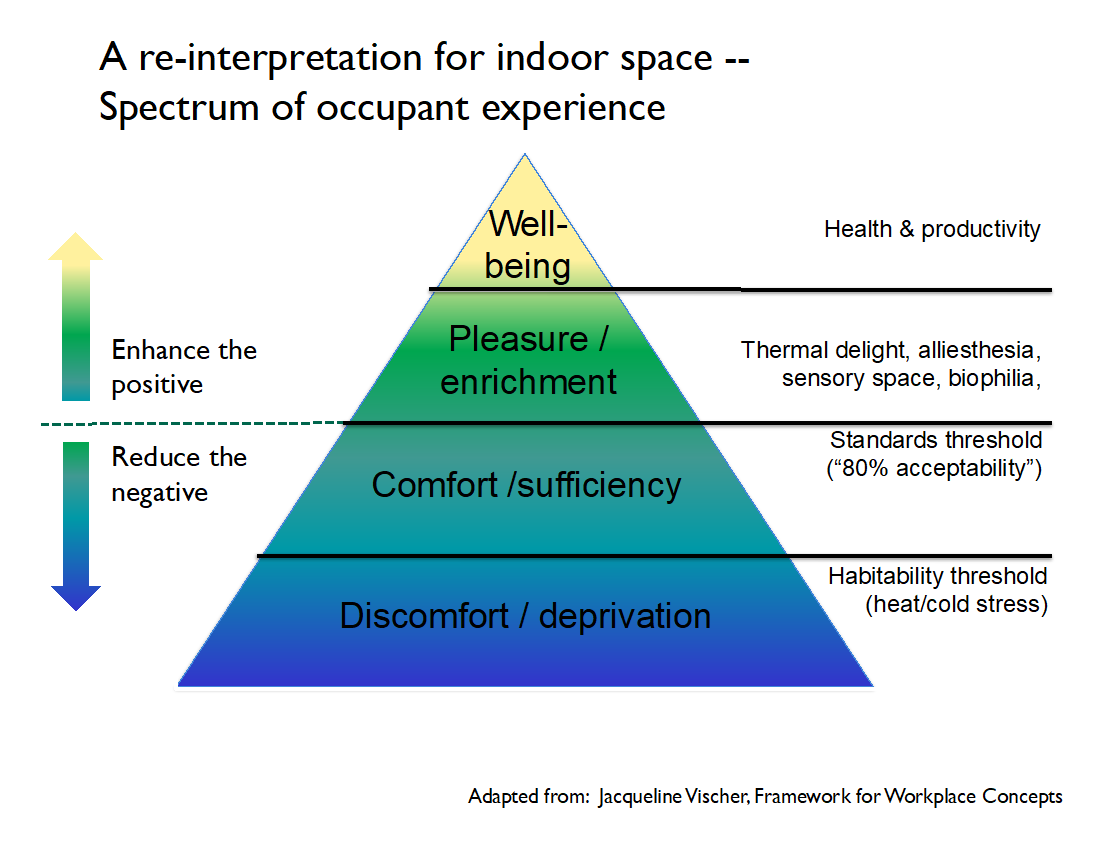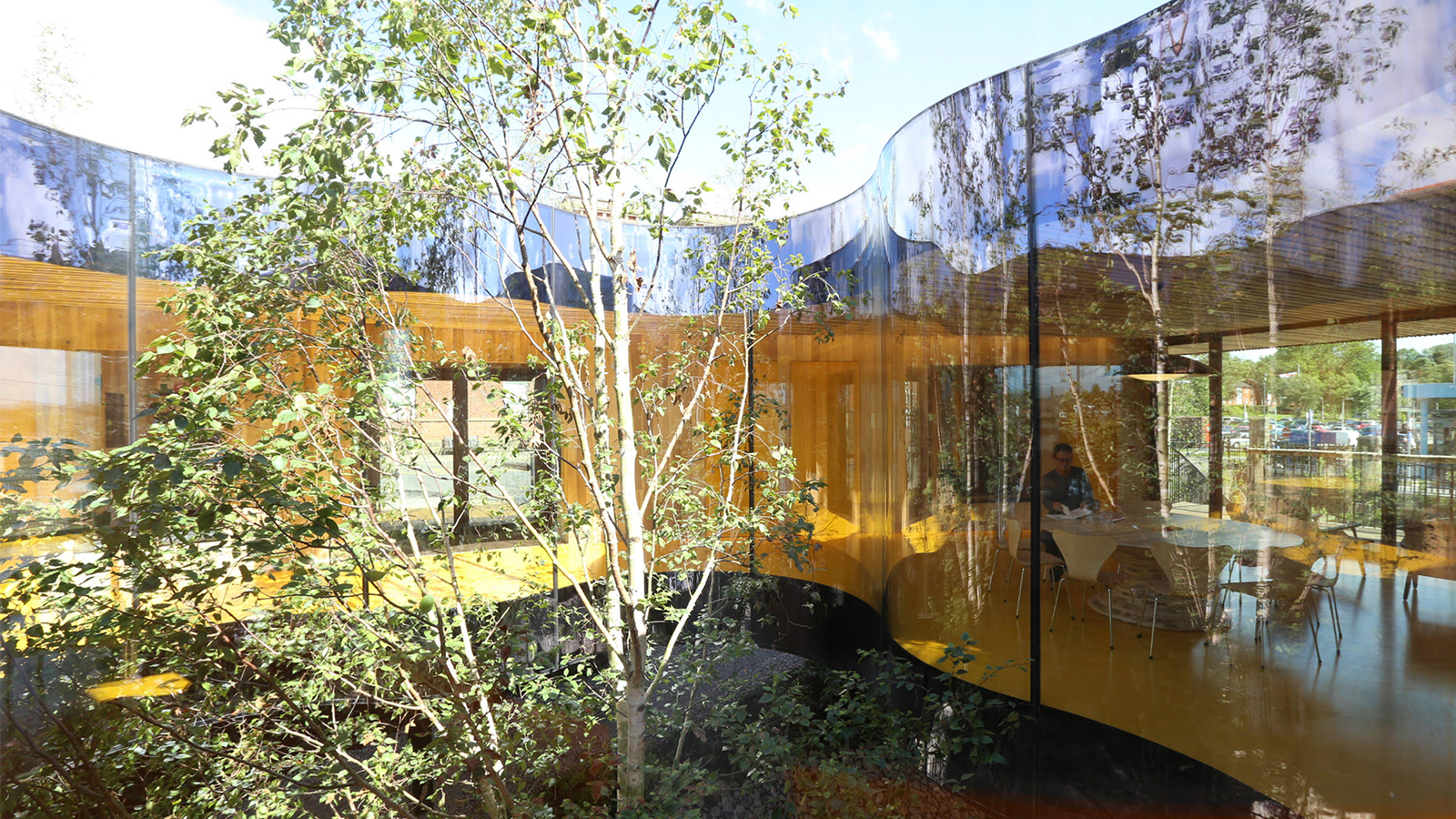Too often, today’s buildings are not only designed without the planet in mind, but they also neglect the occupant. Imagine for a moment what would life be like if we ate the same foods at every meal, never experienced weather or changing light, listened to a constant sound without music or bird songs, and had no art in our lives to delight our visual senses? It would be awful! Yet that’s essentially what we are doing in our indoor environments when we design for static, uniform and neutral conditions in our buildings, often dissociating people from nature and the inherent cycles of the natural environment. This is experiential monotony, and there’s nothing pleasurable about it.
Building standards and conventional building are all about ’reducing the negative‘, built on the premise that if no one notices indoor environmental qualities, then this is considered success. But what if we aimed to ’enhance the positive‘, to create indoor environments that are not only comfortable and healthy, but are connected to nature, provide a sense of place, and are a delight to be in. Designing for experience requires us to embrace a broader view of experiential aesthetics, moving beyond the primacy of vision in aesthetics and recognize that broader sensual qualities of the built environment contribute to the beauty and memorability of space.
To create a framework for thinking about this, we can borrow from Maslow’s hierarchy of needs, which suggests that we need to first satisfy our basic requirements for life — breathing, food, water — before we aspire towards our higher desires for love and self-worth and creativity. We can reinterpret this hierarchy as one of sensory experience, as shown in the figure below (focusing on the area of thermal comfort, but applicable to other senses as well). At the lowest level, the goal is simply to avoid heat and cold stress, and is often the basis for occupational safety and health standards, or guidelines for resilient buildings to be habitable in the event of power outages during natural disasters. Moving upwards, our buildings are generally operated to meet the next level — where the goal is simply thermal neutrality (or absence of feeling, which could even be equated with a mild form of sensory deprivation). A familiar example is ASHRAE Standard 55, which prescribes conditions in which 80% of the occupants will find the conditions “acceptable,” or conversely that it’s okay if 20% of the occupants are unhappy. Many would argue that this is not very aspirational, and that we need to aim for a higher level of experiential delight, expressed in the third level. The burgeoning field of biophilic design, where a greater connection to nature is provided within the built environment, is certainly built on this premise. And at the top is the idea of well-being, with a goal of creating environments that support our physical, social and emotional health, and also our cognitive function and productivity.

The spectrum of occupant experience (Brager, adapted from Vischer, 2007).
But how do we get beyond mere “comfort” and design for these higher level experiences? One premise is that the key to moving upward on this pyramid is variability, which can have benefits for our health, cognitive performance and overall experiential delight.
As one example of health benefits, one study found that exposure to mildly cold or warm environments outside of the standard comfort temperature range increases metabolism and energy expenditure which can help to tackle obesity. The study also found that for those with Type 2 diabetes, exposure to mild and intermittent coldness influences glucose metabolism and increased insulin sensitivity by more than 40%, which is comparable with the best pharmaceutical solutions available. The authors of the study have advocated therefore that buildings (including homes and offices) should adopt drifting temperatures to create a healthier environment.
There have been limited but interesting studies on the effects of variability on our cognitive performance. As one example, a study exposed subjects to both constant and sawtooth temperatures with similar mean values and found that the variable temperatures reduced symptoms of drowsiness and difficulty in concentration. Although more research is needed in this area, given that the costs of people in office buildings is two orders of magnitude higher than energy operating costs, if variable conditions improved productivity then the building and business communities would find such results quite compelling.
The evidence for variability on our sensory delight is even more compelling that can be summarized adequately in this post. A great deal of that evidence is found in the literature on Biophilic Design. For thermal variability in particular, there is increasing evidence for the concept of alliesthesia — the physiological basis for thermal delight, which also has analogies to other senses as well. The premise is that hedonic sensations of “pleasure” come from the dynamic component of thermoreceptors in our skin. As such, the best potential for alliesthesia will come from having some degree of variability, or contrast, either over time, or across different parts of our body. The heated and cooled chair developed by CBE is certainly a good example of this.
While the environmental control systems in our buildings are becoming increasingly sophisticated, we are not necessarily using them to create a more nuanced palette of sensory qualities. We have shifted from a historical people-based way of conditioning to more centralized space-based systems. Early commercial buildings typically had narrow profiles where open windows permitted breezes to reach the occupants, high ceilings allowed heat to rise away from occupied zones, fans provided cooling in localized areas, and natural lighting for desks near the perimeter minimized the amount of electrical lighting required and the heat gain to be removed. In comparison, today’s buildings typically have flush-skin facades with no shading, low transmittance glass, inoperable windows and large interior zones. They are completely dependent on centrally-controlled air-conditioning and the focus has shifted from the human system to the building system, and occupants generally have little opportunity for controlling their own thermal environments. We need to strive to create indoor environments that are richer in their experiential qualities, provide valuable sensory stimulation, are in tune with the natural rhythms of the outdoor climate, and are connected to social, regional and cultural contexts. In this way, we can hopefully reverse the trend of excessive energy use and experiential monotony to create places that are not only comfortable and healthy, but are connected to the natural environment, provide a sense of place, and are a delight to be in.
Main image: Maggie’s Centre. Photo credit: Alex de Rijke.

